Related Research Articles

Winterthur Museum, Garden and Library is an American estate and museum in Winterthur, Delaware. Winterthur houses one of the richest collections of Americana in the United States. The museum and estate were the home of Henry Francis du Pont (1880–1969), Winterthur's founder and a prominent antiques collector and horticulturist.

Charles Willson Peale was an American painter, military officer, scientist, and naturalist.

University of the Arts (UArts) was a private arts university in Philadelphia, Pennsylvania. Its campus made up part of the Avenue of the Arts cultural district in Center City, Philadelphia. On May 31, 2024, university administrators suddenly announced that the university would close on June 7, 2024, although its precarious financial situation had been known for some time. It was accredited by the Middle States Commission on Higher Education.

Andrew Newell Wyeth was an American visual artist, primarily a realist painter, working predominantly in a regionalist style. He believed he was also an abstractionist, portraying subjects in a new, meaningful way. The son of N. C. Wyeth and father of Jamie Wyeth, he was one of the best-known U.S. artists of the middle 20th century. James H. Duff explores the art and lives of the three men in An American Vision: Three Generations of Wyeth Art. Raised with an appreciation of nature, Wyeth took walks that fired his imagination. Henry David Thoreau, Robert Frost, and King Vidor's The Big Parade (1925) inspired him intellectually and artistically. Wyeth featured in a documentary The Metaphor in which he discussed Vidor's influence on the creation of his works of art, like Winter 1946 and Portrait of Ralph Kline. Wyeth was also inspired by Winslow Homer and Renaissance artists.
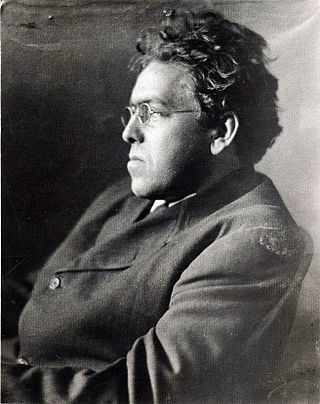
Newell Convers Wyeth, known as N. C. Wyeth, was an American painter and illustrator. He was a student of Howard Pyle and became one of America's most well-known illustrators. Wyeth created more than 3,000 paintings and illustrated 112 books — 25 of them for Scribner's, the Scribner Classics, which is the body of work for which he is best known. The first of these, Treasure Island, was one of his masterpieces and the proceeds paid for his studio. Wyeth was a realist painter at a time when the camera and photography began to compete with his craft. Sometimes seen as melodramatic, his illustrations were designed to be understood quickly. Wyeth, who was both a painter and an illustrator, understood the difference, and said in 1908, "Painting and illustration cannot be mixed—one cannot merge from one into the other."
Kinuko Yamabe Craft is a Japanese-born American painter, illustrator and fantasy artist.

The Pennsylvania Academy of the Fine Arts (PAFA) is a museum and private art school in Philadelphia, Pennsylvania. It was founded in 1805 and is the first and oldest art museum and art school in the United States.
Richard Amsel was an American illustrator and graphic designer. His career was brief but prolific, including film posters, album covers, and magazine covers. His portrait of comedian Lily Tomlin for the cover of Time is now part of the permanent collection at the Smithsonian Institution. He was associated with TV Guide for thirteen years.
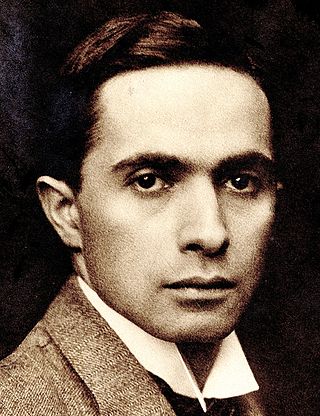
Joseph Christian Leyendecker was one of the most prominent and financially successful freelance commercial artists in the U.S. He was active between 1895 and 1951 producing drawings and paintings for hundreds of posters, books, advertisements, and magazine covers and stories. He is best known for his 80 covers for Collier's Weekly, 322 covers for The Saturday Evening Post, and advertising illustrations for B. Kuppenheimer men's clothing and Arrow brand shirts and detachable collars. He was one of the few known reportedly gay artists working in the early-twentieth century U.S.

Jessie Willcox Smith was an American illustrator during the Golden Age of American illustration. She was considered "one of the greatest pure illustrators". A contributor to books and magazines during the late 19th and early 20th centuries, Smith illustrated stories and articles for clients such as Century, Collier's, Leslie's Weekly, Harper's, McClure's, Scribners, and the Ladies' Home Journal. She had an ongoing relationship with Good Housekeeping, which included a long-running Mother Goose series of illustrations and also the creation of all of the Good Housekeeping covers from December 1917 to 1933. Among the more than 60 books that Smith illustrated were Louisa May Alcott's Little Women and An Old-Fashioned Girl, Henry Wadsworth Longfellow's Evangeline, and Robert Louis Stevenson's A Child's Garden of Verses.
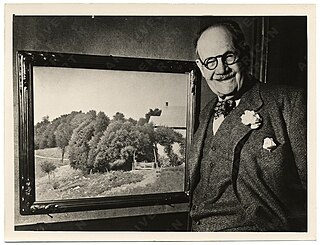
Frank Vincent DuMond was one of the most influential teacher-painters in 20th-century America. He was an illustrator and American Impressionist painter of portraits and landscapes, and a prominent teacher who instructed thousands of art students throughout a career spanning over fifty years.
Robert Remsen Vickrey was a Massachusetts-based artist and author who specialized in the ancient medium of egg tempera. His paintings are surreal dreamlike visions of sunset shadows of bicycles, nuns in front of mural-painted brick walls, and children playing.
Anita E. Kunz, OC, DFA, RCA is a Canadian-born artist and illustrator. She was the first woman and first Canadian to have a solo exhibit at the Library of Congress in Washington, D.C.

Elenore Plaisted Abbott (1875–1935) was an American book illustrator, scenic designer, and painter. She illustrated early 20th-century editions of Grimm's Fairy Tales,Robinson Crusoe, and Kidnapped. Several books were published as illustrated by Elenore Plaisted Abbott and Helen Alden Knipe.
Clara Elsene Peck was an American illustrator and painter known for her illustrations of women and children in the early 20th century. Peck received her arts education from the Minneapolis School of Fine Arts and was employed as a magazine illustrator from 1906 to 1940. Peck's body of work encompasses a wide range, from popular women's magazines and children's books, works of fiction, commercial art for products like Ivory soap, and comic books and watercolor painting later in her career. Peck worked during the "Golden Age of American Illustration" (1880s–1930s) contemporaneous with noted female illustrators Jessie Willcox Smith, Elizabeth Shippen Green and Violet Oakley.
George Alexis Weymouth, better known as Frolic Weymouth, was an American artist, whip or stager, and conservationist. He served on the United States Commission of Fine Arts in the 1970s and was a member of the Du Pont family.
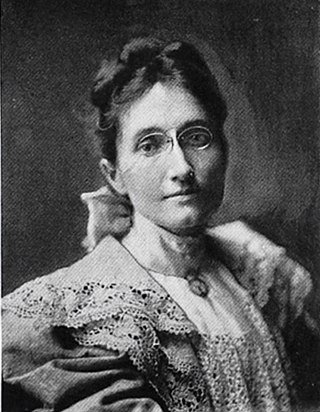
Alice Barber Stephens was an American painter and engraver, best remembered for her illustrations. Her work regularly appeared in magazines such as Scribner's Monthly, Harper's Weekly, and The Ladies Home Journal.
Charles Archibald MacLellan was a 20th-century American painter and illustrator. His works enjoyed a wide-ranging, popular appeal in the United States, and he was probably one of the most recognizable cover illustrators of the day.
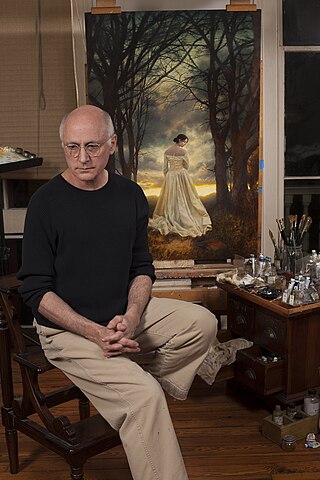
Michael J. Deas is an American realist painter and illustrator whose work is known for both its technical skill and "a growing sense of grace and serenity". He is cited in Roger and Walt Reed's definitive history of illustration, The Illustrator in America. He works primarily in oils and graphite. Deas began creating illustrations while studying fine art in New York during the 1970s. He has since gone on to paint six covers for Time magazine and 25 stamps for the US Postal Service, including likenesses of Tennessee Williams (1995), Marilyn Monroe (1995), F. Scott Fitzgerald (1996), Meriwether Lewis (2004), George H. W. Bush (2019) and Ruth Bader Ginsburg (2023). Other notable works include the US poster for Werner Herzog's film, Aguirre, the Wrath of God, and the cover art for the 20th-anniversary edition of Anne Rice's book, Interview with the Vampire. His most recognizable work is his luminous redesign of the Columbia Pictures logo, painted [with oils] in 1991 and in continuous use since that time.

Thomas Charles Fletcher was a prominent American silversmith and merchant, active in Boston and Philadelphia. His firm of Fletcher & Gardiner was nationally renowned.
References
- ↑ Fred B. Adelson (November 26, 2000). "ART; Narrative Images' Alluring World". The New York Times. Retrieved January 18, 2011.
- ↑ Meyers, Tiffany (September–October 2004). "Charles Santore". Communication Arts. 46 (5): 68–70.
- ↑ "Hamilton King Award". Society of Illustrators. 2010. Archived from the original on September 27, 2011.
- ↑ "The 1998 Storytelling World Award Winners and Honor titles". Storytelling World. Retrieved January 19, 2011.
- ↑ Slotnik, Daniel E. (August 23, 2019). "Charles Santore Dies at 84; Illustrated Classic Children's Books". The New York Times.
- 1 2 3 4 5 6 7 "Charles Santore". Embracing the Child. Archived from the original on August 29, 2003. Retrieved August 13, 2014.
{{cite web}}: CS1 maint: unfit URL (link) - 1 2 "Exploring the Narrative Picture". Society Illustrators. Retrieved August 13, 2014.
- ↑ Home, Fletcher Nasevich Funeral. "Obituary for Olenka Santore | Fletcher Nasevich Funeral Home". Obituary for Olenka Santore | Fletcher Nasevich Funeral Home. Retrieved December 29, 2022.
- ↑ "Charles Santore". Communication Arts. September 4, 2004. Retrieved December 29, 2022.
- ↑ Cook, Bonnie L. (August 16, 2019). "Charles Santore, 84, nationally known illustrator from South Philadelphia". www.inquirer.com. Retrieved December 29, 2022.
- ↑ "Charles Santore, Illustrator of Children's Books & Windsor Authority, Dies at 84 - Antiques and the Arts WeeklyAntiques and the Arts Weekly". Antiques and the Arts Weekly -. August 27, 2019.